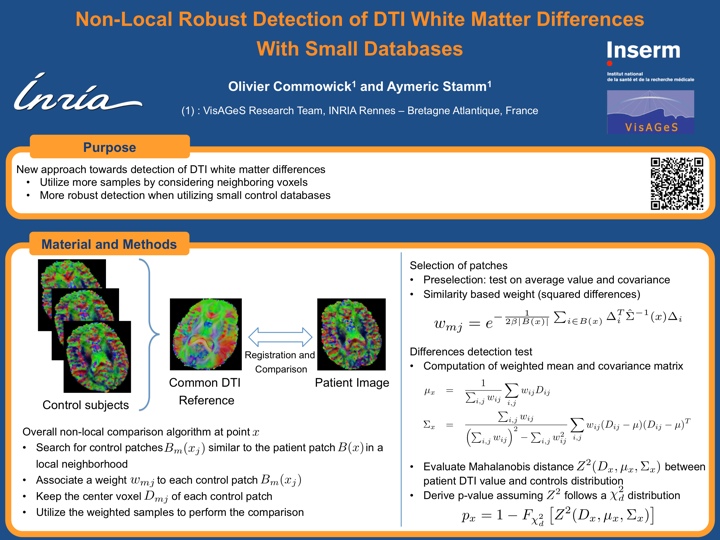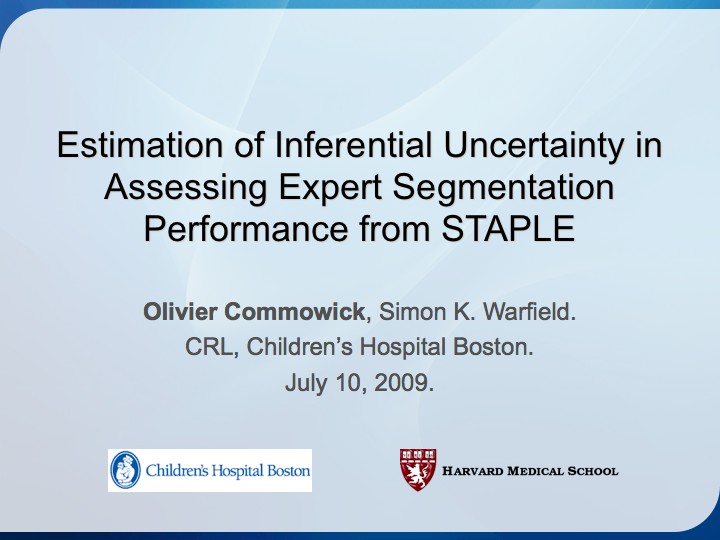
MICCAI 2017 MCM registration poster
This poster explains the work presented at MICCAI 2017 conference on developing new similarity metrics for multi-compartment models registration. We derived SSD like and correlation inspired metrics based on the L2 space of square integrable functions in which the probability density functions and characteristic functions of the MCM fall. We used this framework to derive analytic and numerical approximate metrics virtually applicable to any diffusion compartment type.

MICCAI 2015 MCM interpolation poster
This poster explains the work presented at MICCAI 2015 conference on developing a new and generic diffusion multi-compartment models interpolation method. This is performed by agregating all compartments from the averaged MCMs and the proceeding to their simplification through spectral clustering. We end up with a method allowing us to average any type of compartments as long as a distance and a compartment averaging methods may be defined between them.

MICCAI 2012 block-matching registration poster
This poster explains the work presented at MICCAI 2012 conference on developing robust block-matching non-rigid registration of structures with rigid parts. This is performed by looking for rigid matches between blocks on the images and interpolating them using a new technique called M-smoothing. We demonstrate how this allows for a more robust estimation of the transformation between images with large local rotations such as dynamic cervical MRI.

MICCAI 2012 Non-Local DTI comparison poster
This poster explains the work presented at MICCAI 2012 conference on developing robust DTI differences detection, even with small databases, using a non-local approach. For each voxel to be compared to a group of control images, we look for additional patches to compare to in a close neighborhood. These new patches are in turn utilized to perform the comparison with a slightly modified test to handle weighted samples. We demonstrate how this approach allows for more robust detections and more reproducible comparison results with small databases.

ISBI 2012 poster
This poster explains the work presented at ISBI 2012 conference on developing robust block-matching rigid registration by looking for rigid matches between blocks on the images. We demonstrate how this allows for a largely improved robustness over classical block-matching. In addition, the algorithm also converges faster, making it at least as fast as previous algorithms.

MICCAI 2011 tutorial lecture
This presentation was given at the MICCAI 2011 tutorial on shape models for biomedical image segmentation. It aimed at presenting adapted registration algorithms for atlas based segmentation, as well as an overview of recent algorithms to construct patient adapted atlases and how they can improve segmentation performance of the head and neck region.

MICCAI 2010 poster
This poster explains the work presented at MICCAI 2010 conference on the incorporation of prior parameters on performance parameters for the STAPLE algorithm. We demonstrate that adding these priors on performance allows to deal perfectly with datasets with missing structures. This will allow to ask less delineation from the experts (less time consuming) while obtaining similar evaluation results.

MICCAI 2009 IADB workshop presentation
These slides present our work on the detection of differences in DTI images of fetal growth restricted patients treated using standard care or patient adapted NIDCAP care. This is based on the construction of a DTI atlas and the robust comparison of groups using our new continuous STAPLE algorithm. This article was published at the workshop on Image Analysis of the Developing Brain, held in conjunction with MICCAI 2009.

MICCAI 2009 poster
This poster explains the work presented at MICCAI 2009 conference on the construction of an atlas locally adapted to the patient to delineate. This is further explained on this page. We present a novel method to select locally on predefined regions the most similar image to the patient, as well as a novel atlas construction method to combine the selected images into a Frankenstein's creature for segmentation.

IPMI 2009 conference presentation
These slides present our work on deriving confdence bounds on the parameters estimated through the STAPLE validation algorithm. The covariance matrix is computed as the inverse of the information matrix of the parameters, which is derived from the Log-likelihood function used in STAPLE. This article was published at IPMI 2009 conference.

CAOS'09 presentation
These slides (invited talk given at CAOS workshop) present an atlas construction method to build a head and neck atlas for radiotherapy planning. Such an atlas will then be registered on the patient's image to get the critical structures segmentations to plan the treatment. Moreover, the methods introduced are generic (may be applied on any region or application) and very important when computing statistical models.

MICCAI 2008 poster
This poster explains the work presented at MICCAI 2008 conference on the detection of DTI white matter abnormalities in MS patients images. This is further explained on this page. We present a full-tensor based comparison is performed between MS patients and a database of control subjects, by constructing a DTI atlas of controls and using it to detect differences in each patient.

MICCAI 2007 poster
This poster explains the work presented at MICCAI 2007 conference on the efficient selection of the most similar image for the segmentation of head and neck critical structures. This is further explained on this page. We describe the selection measure developed along with its use to efficiently select the most similar image in a database. It is then evaluated on head and neck delineation.

PhD defense slides
These slides present my PhD work. In this presentation are described novel registration methods, atlas construction techniques and their evaluation to develop and use an anatomical atlas of the brain and the head and neck for the delineation of critical structures in patients undergoing a radiotherapy treatment.